The Solar Eclipse Takeaways
Air Date: Week of April 12, 2024
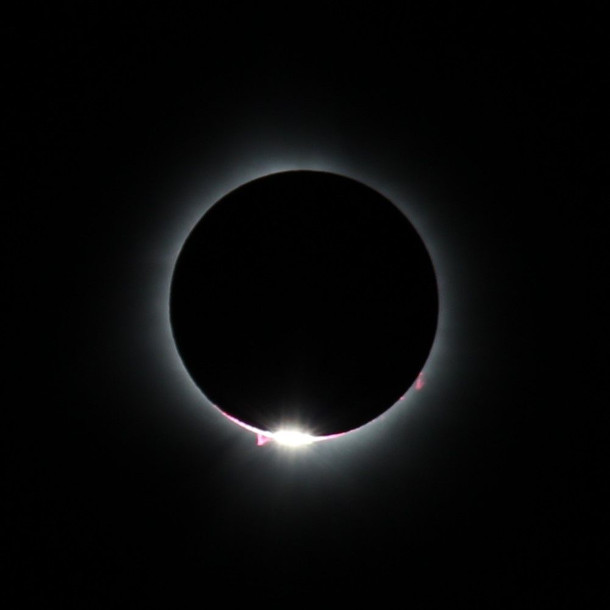
Living on Earth’s Jenni Doering, Steve Curwood, and Aynsley O’Neill all got a chance to see the total solar eclipse in the Northeast. Jenni Doering’s friend, Tina Chen, took this picture of the moment of totality. (Photo: Tina Chen)
The 2024 Great American Eclipse is now in the history books but still front of mind for Host Steve Curwood and Living on Earth’s Aynsley O’Neill and Jenni Doering. They gather to swap stories about experiencing totality and shed light on some of the strange phenomena of the April 8 total solar eclipse.
Transcript
CURWOOD: Well, it's been a few days since the total solar eclipse, but we're still taking it in, and with me now are Living on Earth's Jenni Doering and Aynsley O'Neill, here to share their experiences and reactions. Jenni, tell me, what happened to you when you were chasing this eclipse?
DOERING: Hi, Steve. Yeah, wasn't this amazing? We had beautiful weather. I went up to New Hampshire, a little town called Colebrook. It's right along the Vermont border. The Connecticut River is the border. And you know, despite all of the crowds on the way to the eclipse and coming back, it was so worth it.
CURWOOD: And what about you, Aynsley?
O'NEILL: Yeah, I had an awesome time; a group of friends and I road-tripped up to Vermont. We found this little town called St. Johnsbury, which was supposed to have beautiful clear skies and boy, did it! And so we were able to stretch out on this baseball field with a couple of other groups of people. One nice family even let us use their filtered telescope, which was really awesome. And it was just a really cool time to come together with all these people.
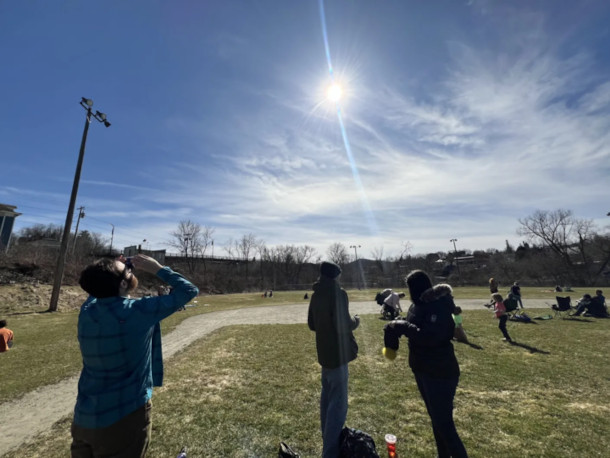
Producer Aynsley O’Neill (right) stands in a baseball field in St. Johnsbury, Vermont to eclipse-watch with her friends. (Photo: Gabe Trotz)
CURWOOD: Yeah, I went pretty close to where both of you were, also in northern New Hampshire, a little town called Errol. St. Johnsbury is just across from Lancaster in northern New Hampshire. I don't think they'd seen as many people there in probably the whole last century. But we were part of a nice, large, friendly crowd behind a furniture store. Some folks had turned it into tailgating, they had grills and everything going, even though of course, it's mud season this time of year.
DOERING: Oh, yeah.
CURWOOD: And when the totality hit, I spotted some bats flying--
O'NEILL: Whoa.
CURWOOD: --at three in the afternoon.
DOERING: Oh, that's cool.
O'NEILL: Oh, there was nothing like totality. It was so cool to see the sort of night come on so quickly. I saw Venus and Jupiter really bright in the sky. But I wish I had been able to see some stars too.
DOERING: I saw a few stars. I saw the planets, and did you see the ground rippling?
O'NEILL: The rippling? No.
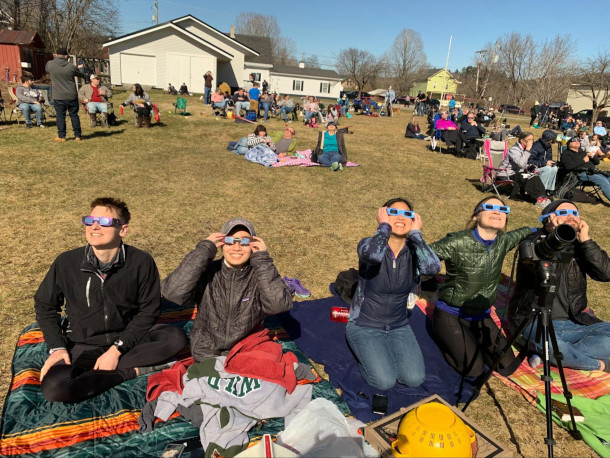
Managing Producer Jenni Doering (second from right) and her friends watched the 2024 total eclipse from Colebrook, New Hampshire. (Photo: Courtesy of Jenni Doering)
DOERING: So, there were these like shadows moving across the lawn where I was. And I saw other people noticing this too, and like kind of pointing and gaping at it. And I Googled it later, I guess it's called shadow bands. And scientists don't even know really what causes this. But they think that it is basically when the sun is down to this tiny sliver, that the rays of light are moving through the turbulence in the atmosphere and getting distorted. And kind of similar to what makes the stars twinkle.
O'NEILL: Well, I mean, the whole time leading up to and leading away from totality was pretty cool, too. I thought it was so interesting how the color sort of sapped from the landscape. What I found out is that your eyes are stopping using the cones as much and starting to use the rods. So longer wavelength colors like red are starting to dim, and shorter wavelength colors like blue and green are starting to pop. And because it happens so quickly during the eclipse, it's really kind of surreal, and everything looks kind of metallic.
CURWOOD: Yeah, but there was some red, actually, it was in the corona of the sun there—bright red spots along the edge of the disk. I wondered if they were solar flares. But then someone in the crowd mentioned prominences?
DOERING: Yeah, Steve, those were so bright, I was honestly worried that they were going to hurt my eyes. So I kept putting my solar glasses back on, just to check. But I read that they're actually part of the sun's super hot plasma that kind of arcs out following the powerful magnetic fields that the sun has. And unlike a solar flare, they kind of stay attached instead of flinging off into space.
CURWOOD: Yeah, this is really, of course, a huge, extremely powerful fusion reaction that we were watching there, hydrogen getting fused into helium, there's a ton of energy. So as totality came on, the temperature went down, and we had to put on our sweaters.
DOERING: Us too!
O'NEILL: Oh, it got chilly!
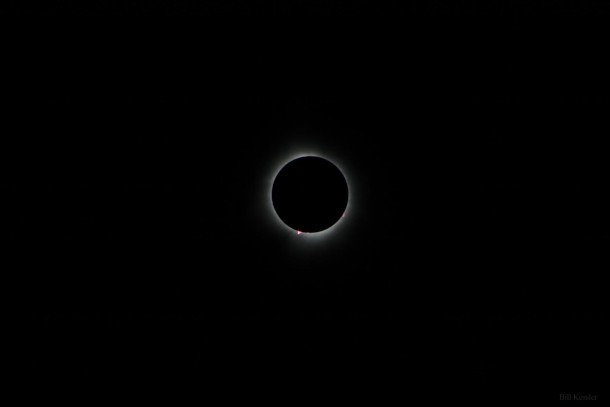
Executive Producer Steve Curwood captures totality in Errol, New Hampshire. (Photo: Steve Curwood)
DOERING: It was weird. The sun was like, visibly weakening, noticeably weakening. I guess researchers were expecting some solar energy production drop as a result of this eclipse. So the National Renewable Energy Lab, NREL, they predicted that it might drop by as much as 35 gigawatt hours along the path of the eclipse.
O'NEILL: Ooh, it's going to be interesting to see all this data coming in. Even with just a couple of minutes of totality, I'm sure so much science was being done. Although, you know, we only had a couple of minutes, but there are ways to get more than a couple of minutes. I found out that in 1973, a group of scientists chartered a supersonic Concorde jet to chase the eclipse. They got something like 70-plus minutes. I am so jealous!
DOERING: That's a long eclipse!
O'NEILL: That's a long eclipse.
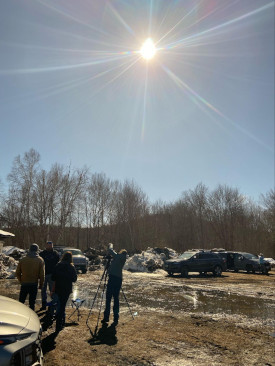
Steve Curwood’s group braved the mud to watch the eclipse. (Photo: Steve Curwood)
CURWOOD: And well, so what about chasing eclipses? When's the next one?
DOERING: Yeah, so I guess there's an annular one coming up this October. But what that means is that the moon is farther away. And so it's actually not big enough to block out the entire sun like this eclipse was.
CURWOOD: Hmm, so I guess any eclipse chasers or umbraphiles, as they are sometimes called, will need to wait until August of 2026 and travel to either the Arctic or Western Europe to catch a glimpse.
O'NEILL: And since it's not going to be in the US, a couple of us might be looking to hang up our eclipse glasses, and you can find out more about how to donate them on our webpage, loe.org.
CURWOOD: Well, science is always interesting, but who knew that science could be so much fun?
DOERING: A lot of fun—and really memorable.
O'NEILL: And really enjoyed in a crowd. That was awesome.
Links
Living on Earth wants to hear from you!
Living on Earth
62 Calef Highway, Suite 212
Lee, NH 03861
Telephone: 617-287-4121
E-mail: comments@loe.org
Newsletter [Click here]
Donate to Living on Earth!
Living on Earth is an independent media program and relies entirely on contributions from listeners and institutions supporting public service. Please donate now to preserve an independent environmental voice.
NewsletterLiving on Earth offers a weekly delivery of the show's rundown to your mailbox. Sign up for our newsletter today!
 Sailors For The Sea: Be the change you want to sea.
Sailors For The Sea: Be the change you want to sea.
 The Grantham Foundation for the Protection of the Environment: Committed to protecting and improving the health of the global environment.
The Grantham Foundation for the Protection of the Environment: Committed to protecting and improving the health of the global environment.
 Contribute to Living on Earth and receive, as our gift to you, an archival print of one of Mark Seth Lender's extraordinary wildlife photographs. Follow the link to see Mark's current collection of photographs.
Contribute to Living on Earth and receive, as our gift to you, an archival print of one of Mark Seth Lender's extraordinary wildlife photographs. Follow the link to see Mark's current collection of photographs.
 Buy a signed copy of Mark Seth Lender's book Smeagull the Seagull & support Living on Earth
Buy a signed copy of Mark Seth Lender's book Smeagull the Seagull & support Living on Earth

